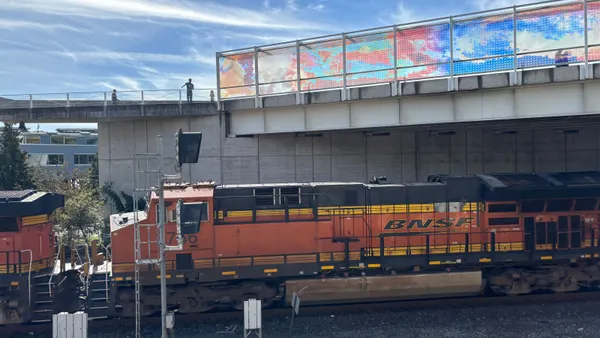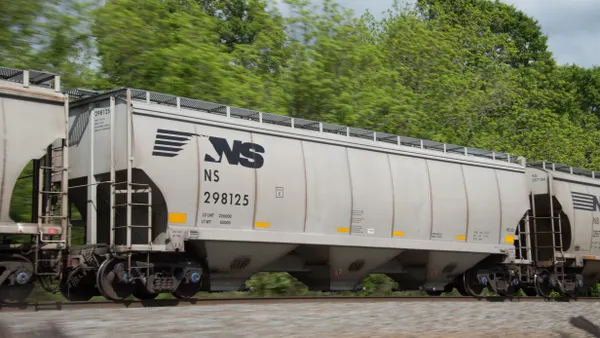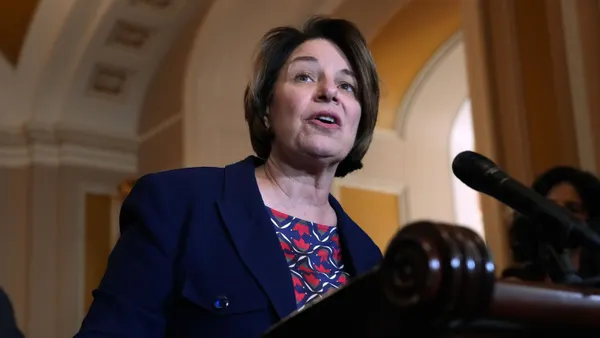Dive Brief:
- Freight volume was up 4% year-over-year (YoY) in the first quarter for Kansas City Southern (KCS), but a 26% month-over-month drop in train starts as of April 15 — exacerbated by the timing of the Easter holiday — portends a much tougher second quarter. Executives pulled back previously issued guidance on a Friday earnings call.
- The impact of COVID-19 upheaval was limited in the first quarter, Chief Marketing Officer Mike Naatz said. Automotive shipment carloads were down 12% YoY and energy shipments were down 5% YoY, but all other segments, including intermodal, were up in volume year-over-year. KCS was again bolstered by cross-border freight with volume coming over the U.S.-Mexico border up 12% YoY in the quarter ending March 31.
- The true impact of the coronavirus outbreak on the railroad won't be reported until subsequent quarters and executives indicated KCS customers are already feeling the pain of decreased demand and supply chain interruptions. "Not surprisingly, given the circumstances, we have received some requests for accommodation from our customers. Our pricing strategy to achieve inflation plus pricing remains the same," Naatz said.
Dive Insight:
"[PSR] has put us in just outstanding position to respond to this latest extraneous curveball that we've been dealing with and the rapidly changing business environment has put us very much on our toes," CEO Patrick Ottensmeyer said.
An even more aggressive focus on efficiency will get KCS through the COVID-19 crisis, which hit the automotive industry — a particularly important customer segment — hard and early, executives said. The railroad plans to leverage the precision-scheduled railroading (PSR) playbook even more. In the first quarter, the railroad increased train velocity by 26% YoY and decreased dwell 9% YoY.
Retiring locomotives has been a key part of KCS and its peers' transitions to PSR. The railroad has removed 20% of its fleet since adopting PSR in January 2019, and COVID-19 spurred the railroad to pull locomotives out of the system with more urgency than before, Sameh Fahmy, executive vice president for PSR, said on the call.
Taking equipment out of the system without a model for what that might do to the network was a favorite play of the original PSR coach Hunter Harrisson, Fahmy said. KCS has avoided that drastic style of efficiency-seeking to date, favoring a more planned approach, but as factories in Mexico began to close, the railroad changed its tune.
"You take the assets out and then make it work, and it did work," Fahmy said. The railroad removed an additional 50 locomotives in this fashion in reaction to the COVID-19 outbreak.
The trick for KCS, and all Class I railroads, is the same challenge many global businesses are facing right now: How does a business cut costs to weather the short term without damaging its ability to respond quickly when demand returns?
Coordinating with customers is one way. Railroads, automotive manufacturers and railcar pooling company TTX has instituted a weekly conference call aimed at being prepared for a return to more normal business volumes, Naatz said.
"We are very focused on remaining to be prepared for a return of volume growth whenever that happens," Ottensmeyer said.
Ensuring continuity of service is another element of this strategy. COO Jeff Songer classified the social distancing efforts undertaken by the railroad not as a public health measure, but as essential to business continuity — physically separating network operations and dispatching teams, for example.
What the railroad isn't counting on to help balance a dip in manufacturing is any rise in intermodal volume. Intermodal carloads were up 6% YoY in the first quarter, but KCS is currently at a currency disadvantage.
"With the weakening peso that provides trucking with an additional advantage there," Naatz said. "We are seeing that pressure and we continue to see that pressure into the near future."














